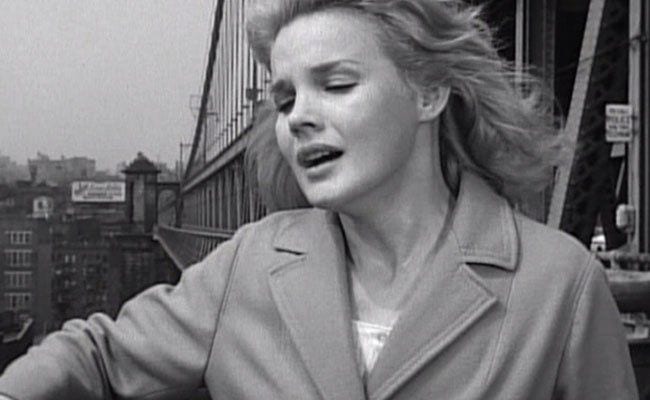
Something Wild is an unusual independent drama that blipped briefly below the public radar in 1961, then largely disappeared apart from occasional TV appearances. In the last few years, this restored item has resurfaced for sightings at art houses and on TCM, thanks partly to the efforts of critic/programmer Kim Morgan, and was issued in MGM’s on-demand Limited Edition DVD series.
Now it’s elevated to the ranks of Criterion Blu-ray for the widest possible access to curious connosseurs. More than 50 years after it bewildered critics, it remains a strange and provocative button-pusher.
The thrilling score by Aaron Copland begins bursting through the screen, all shrieks and thunder amid bustling, geometric, semi-abstract images of New York put together by great title designer Saul Bass. It’s quite a fanfare for what will prove an intimate, interiorized psychological study of Mary Ann (Carroll Baker), a student who literally skips off the train on her way home from school one day only to be grabbed and dragged into the bushes by a large pair of arms attached to a shadowy hulk.
Struggling, she’s forced to the ground where a series of discreet close-ups and edits convey something that possibly no American film had come so close to depicting. Her cross necklace drops off because God isn’t looking, or else her faith is falling away.
Rape had been a topic forbidden under the studio era’s Production Code when even the word wasn’t used. In 1948, the groundbreaking Johnny Belinda featured the discreetly implied rape of its heroine (Jane Wyman, winning an Oscar) whose status as a deaf-mute ironically commented on the “unspeakable” nature of the topic and its “speak no evil, hear no evil” status.
Mary Ann, too, never speaks of what happened, and spends the rest of the film hardly speaking at all. She feels unable to broach the subject with her mother (Mildred Dunnock), and instead has a hostile generation-gap resentment towards her. During one elliptical conversation, the mother laments what she perceives as a deteriorating Bronx neighborhood where people shouldn’t walk alone, causing Mary Ann to demand harshly what might happen, daring her mother to spit it out. “Anything,” she replies.
The scenes of the aftermath are grim and closely observed as Mary Ann sneaks into her home, takes a shower and cuts up her clothes. She will feel so alienated from her previous life that she ditches it for a new one, telling nobody as she finds a job and a cheap apartment into which she retreats like a shell. This segment is a festival of appearances by New York actors who would later achieve fame: Doris Roberts as an annoyed co-worker, Clifton James as a cop, Jean Stapleton as a slatternly neighbor who sprawls around in a slip and wants to introduce Mary Ann to “one of my better gentleman friends”.
Since the topic itself had hardly been explored in American cinema, no film had gone so far in its depiction of the psychological aftermath of rape or trauma in general. The ambiance mixes realism, the naturalistic Method approach of the Actors Studio from which Baker and her filmmaker husband Jack Garfein emerged, plus expressionism and even dream-sequence surrealism. The great photographer Eugen Schüfftan, who was about to win an Oscar for the same year’s The Hustler, combines the city’s unglamorized black and white clarity with dream images recalling his recent French horror film Eyes Without a Face (1959).
The deal-breaker for many critics in 1961 and possibly for many of today’s viewers is the agonized psychodrama of the last half, set in the dingy basement flat of a bipolar alcoholic “minotaur” (Ralph Meeker), or rather a cyclops. If this flat symbolizes the subconscious, the man represents the legacy of her attacker, who has moved into her soul and imprisoned her until she comes to a resolution that requires living with this experience for the rest of her life. I’m spelling out this psychological level explicitly rather than give away the surface drama, which may be too “unbelievable” and disturbing for those in search of realism.
In an interview with Morgan, Garfein says United Artists wanted him to make a movie with a therapeutic approach (have her talk to a priest and meet a nice boy) in keeping with what he perceives as the American impulse to “put the past behind you”. As an Auschwitz survivor who lost his entire family, he was struck by this attitude in his new country, and he made a film directly about his own psychological experience of having your life divided cleanly into a cataclysmic before and after. For him, the rape drama he directed, as enacted by his wife, is a displaced representation of the Holocaust.
Baker also provides an interview, discussing the sexual elements in her roles such as Baby Doll (1956) and The Carpetbaggers (1964). Most illuminating is an interview with critic Foster Hirsch, who discusses Garfein’s career and his two feature dramas, the other being The Strange One (1957) with Ben Gazzara, as strict products of the Actors Studio. He says that while some critics dismissed the pas de deux, or folie à deux, between Baker and Meeker as an Actors Studio exercise, you won’t see a purer example of “the Method” on film. Completing that side of the package is an excerpt from a 2014 Master Class with Garfein among actors.

